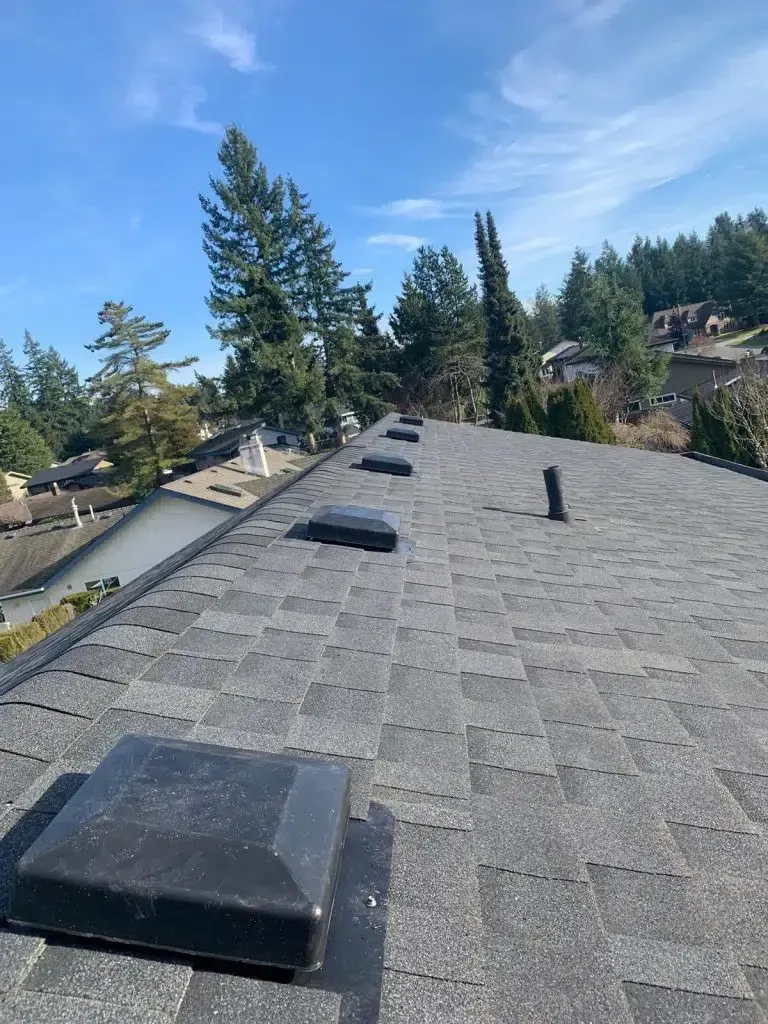Signs It's Time to Replace Your Roof in North Delta
North Delta’s wet winters and salty Fraser River air silently wear roofs thin; when “Signs it’s time to replace your roof in North Delta” appear—age, leaks, sagging—act fast or pay more later.
- Spot missing or cracked shingles after storms.
- Notice asphalt granules clogging gutters.
- Inspect attic for daylight or damp insulation.
- Check for spongy or sagging roof decking.
- Track roof age—20 + years demands planning.
| Factor | Value | Note |
|---|---|---|
| 3-Tab Asphalt | 15-18 yrs | Least storm-resilient |
| Architectural Asphalt | 20-25 yrs | Common in North Delta |
| Metal Standing Seam | 40-50 yrs | Best against coastal rain |
Rain-soaked Eaves to River-cooled Rafters: Why Delta Roofs Age Differently
Up here on the lip of the Fraser, roofs live a double life. One minute they’re basking in a July heat dome; the next they’re riddled by sideways November rain that dumps 200 mm in a week. I’m Harman from Paragon Roofing BC, and I’ve pried up enough damp plywood in Annieville and Sunbury to know our micro-climate doesn’t just age shingles—it hyper-ages them. Let’s break down every tell-tale sign, cost cue, and safety whisper so you can swap that tired lid before it morphs into a money pit.
1. Shingle Clues: The Shiver Before the Shear
Roofs speak in crumbs. When coarse, pepper-grey granules pepper your downspout filter, they’re not random—they’re sunburnt asphalt shingles exfoliating under UV fatigue and freeze-thaw torsion. Missing tabs? Think of them as teeth knocked out by jet-stream-fed gusts roaring up Highway 91. Cracks running longitudinally? That’s thermal splitting, a warning siren that underlayment hydration will soon follow.
Delta-specific tip: our frequent dew points hover near ambient night temps, creating near-constant micro-condensation. This hastens the erosion of the oxidized asphalt layer far quicker than in interior BC towns.
2. Decking Distress: The Spongy Step Test
Ever walked your roofline (carefully roped, please) and felt a subtle trampoline bounce? That’s OSB or plywood sheathing delaminating—usually from water intrusion at fasteners. Home inspectors in North Delta’s 1970s neighbourhoods report that 4-in-12 pitched roofs with original 3/8-inch plywood are now sagging between trusses. Ignore that flex and you invite structural deflection…and insurance red flags.
Pro move: during a clear sunrise, sight along the ridge while standing at ground level. A gentle sway line foretells deck fatigue even before leaks manifest indoors.
3. Attic Micro-Climate: Delta’s Invisible Culprit
Small house, big humidity: river proximity plus modern airtight renovations trap moist air; without proper roof-ridge ventilation, attic RH spikes past 60 %. Watch for mold halos around nail tips or frost glazing the underside of sheathing on crisp February dawns. Both scream, “Vent me—or replace me.” Need a detailed roof inspection checklist Delta ? We have you covered.
4. Flashing & Fasteners: Galvanic Battles at the Coast
North Delta’s mild winters keep galvanized steel wet but rarely frozen, the perfect chemistry set for galvanic corrosion. Check chimney step flashing: is it tinged orange, edges curled? Galvalume drip edges last longer, yet even they pit once road-salt spray drifts from the Alex Fraser Bridge. Swap out failing flashings or plan for full-system replacement if rust has already crept beneath starter strips.
5. Age + Code Drift: When 1990 Meets 2025
A 25-year-old roof may look okay, but building codes didn’t require modern ice-and-water membranes back then, nor today’s hurricane-grade nailing patterns (let alone BC’s 2022 Energy Step Code insulation mandates). Upgrading lets you dodge future permit headaches while slashing heating bills by 15 %. In other words—timing replacement isn’t just about leaks; it’s about future-proofing.
Cost Signals: Dollars Dripping Through the Ceiling
Patch jobs feel thrifty until the third call-back fee eclipses new-roof financing. In North Delta, asphalt replacement averages $10–$12 per sq ft(tear-off included), yet chronic leaks can devalue a property by $30 k+ overnight. For precise numbers, dive into our delta roof cost guide.
Material Matchmaking for Delta’s Climate
| Material | Storm Rating | Noise | Upfront Cost | Lifespan |
|---|---|---|---|---|
| Architectural Asphalt | ★★★ | Low | $ | 20-25 yrs |
| SBS-Modified Asphalt | ★★★★ | Low | $$ | 25-30 yrs |
| Standing-Seam Metal | ★★★★★ | Med | $$$ | 40-50 yrs |
| Euro-Slate Rubber | ★★★★ | Low | $$$ | 30-40 yrs |
Local Insight: Our crews find metal resists cedar pollen staining better along Nordel Way, while SBS deals with hail ping better in Sunshine Hills.
Seasonal Strategy: Pick Your Window
- Spring (Apr–Jun): Best weather predictability; supplier stock high.
- Summer (Jul–Aug): Hot decks; adhesive seals fastest; worker safety management mandatory.
- Fall (Sep–Oct): Rush season—book early or face wait-lists.
- Winter (Nov–Feb): Only emergency re-roofs; cold slows sealant cure.
Case Study: 89A Gunderson Drive
Marjorie’s 22-year-old architectural roof looked “fine” from the street. Our drone thermal scan revealed 6-degree heat loss at eaves and 3 soft-deck hotspots. Tear-off uncovered black mold rings on insulation. A 28-square upgrade to coated steel panels, added ridge vents, and swapped R-20 bats for R-38 cellulose. Result: attic humidity dropped from 65 % to 42 %, hydro bill shaved $39/month, and the appraisal jumped $46 k. That’s Delta math.
Safety First: Why Waiting Hurts
Roof leaks seldom drip straight down; water meanders, saturating wall studs and electrical chases. One Annieville homeowner delayed, then faced a GFCI breaker flashover that torched $18 k in drywall and wiring. Replacement would have been half that cost.
Insurance & Warranty Nuances
- Insurers may add a depreciation clause once roofs exceed life expectancy, slashing payouts.
- Manufacturer warranties transfer only if installed by certified contractors—Paragon holds GAF, Malarkey, and VicWest badges.
- Municipal rebates: Delta occasionally offers stormwater fee credits when upgrades include rain-water management.
Environmental Upside
Old asphalt becomes roadbed aggregate; new reflective shingles drop cooling loads by 10 %. Plus, swapping a moldy roof slashes hidden indoor allergens—good news in the allergy-rife Lower Mainland.
DIY Detection Checklist (Print & Pin)
- Scan ceilings for tea-stain rings monthly.
- Clean gutters every equinox; log granule debris.
- Photograph roof planes annually from the same spot; compare.
- Open attic hatch on cold mornings; check for breath mist.
- Keep a running “roof age + repair spend” total—replace when costs near 35 % of new install.
Frequently Asked Delta Questions
How long will a new asphalt roof actually last here?
Two to three decades, but only with moss control and annual gutter flushes.
Does moss always mean replacement?
No—light moss can be treated. Thick mats usually reveal shingle rot underneath.
Can I reroof over old shingles?
BC code permits one overlay, yet hidden deck rot often makes full tear-off smarter.
Metal roofs—too noisy in rain?
Modern underlayments dampen drumming; most owners say it’s a soft patter, not a racket.
Final Takeaway
Roofs are like brakes—you can drive on squeal for a while, but the crash cost is brutal. North Delta’s climate dishes out more roof-aging moments per year than most Canadians realise. Spot the signs early, budget accordingly, and partner with Delta roof replacement experts who know our postcode quirks. Your soffits, wallet, and sleep will thank you.



